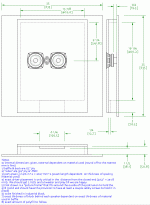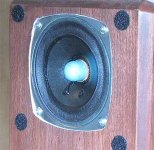I tried setting up a spreadsheet to check for coincidence between harmonics in one direction and harmonics in the other of a rectangle, then tweaking to find numbers that minimised coincidence. Um. Golden Ratio wasn't very good. Lovely number though (and good for pyramids). 13/7 came out out quite well...
Hi
Why wasn't it good? I'd be interested in your findings.
Here are the standing wave harmonics for an enclosure with dimensions based on the golden ratio (2.6/1.6/1).
I know other ratios work well too. Just curious what your findings were...
When I get a chance I'll try to draw a graph on that webpage that shows how close each harmonic is. I think that might be helpful.
Why wasn't it good? I'd be interested in your findings.
Here are the standing wave harmonics for an enclosure with dimensions based on the golden ratio (2.6/1.6/1).
I know other ratios work well too. Just curious what your findings were...
When I get a chance I'll try to draw a graph on that webpage that shows how close each harmonic is. I think that might be helpful.
Hello Vikash, I couldn't find the orginal spreadsheet, so I had to write another. Unfortunately, I don't seem to be able to persuade it to plot the harmonics of one dimension on the same axis as the harmonics of the other, so I had to look at the numbers. Anyway, the 5th harmonic of the long dimension is very close to the 8th harmonic of the short dimension, which is to be expected, given that 1.618 is quite close to 8/5. I really wish I could persuade it to plot the chart I want...
Hmm. I just tried that and I don't get the same result. What absolute numbers are you using?
On another note, I assume that the 5th and 8th are much less of a problem due to the attenuation at those harmonics (I read somewhere that there's little need to consider after the 8th)
And finally, are those frequencies within the audible range? I don't show anything over 20kHz on that webpage.
On another note, I assume that the 5th and 8th are much less of a problem due to the attenuation at those harmonics (I read somewhere that there's little need to consider after the 8th)
And finally, are those frequencies within the audible range? I don't show anything over 20kHz on that webpage.
EC8010 said:I really wish I could persuade it to plot the chart I want...
Excel?
It really is a 3rd rate piece of software... the 15 year old spreadsheet i use (on a 10 yr old computer) still runs circles around it (even on the 10 yr old computer).
dave
Vikash said:
Harmonics are multiples of the fundamental frequency, rather than octaves...
planet10 said:Excel?
Good grief, no. Lotus123. I will now run for cover from the cries of "Philistine" and "Yer what?"
EC8010 said:Good grief, no. Lotus123.
Simplier than Excel -- i have no real expreience with it. It is still handicapped by the rows & column paradigm.
I use a very obscure product called Trapeze. It is object oriented and the last release was V2.1 in 1987. Because it is object oriented it never caught on, but it allows me to do things in hours that take days or weeks in Excel (i know because i've had to work in Excel).
It is where my official title of "Trapeze Artist" comes from.
dave
Thanks for pointing that out. I've made the changes and see the offending harmonics your were talking about.Harmonics are multiples of the fundamental frequency, rather than octaves...
I was following the spreadsheet (linked earlier in the thread) and that doubles the previous harmonic instead of the fundamental. It all looked a lot nicer then...
High-wire act
Let me guess... Would I need a Mac to run it?
planet10 said:I use a very obscure product called Trapeze.
Let me guess... Would I need a Mac to run it?
finally Golden Ratio issue
In all Fibonacci was right...
the Golden Ratio is a valid standard for about everything one can think of...
For paintings, pictures, movies etc..
the 16/9 stuck it in your throat design from some idiotic marketing people has influenced so many people so badly that I was fearing for the vision of human kind. Fortunately some flat panel makers are now seeing the light, it is to say the Golden Ratio theory and certainly the 4th generation screens will fall back to this size. All other ratios are just not natural and make you move your head more than your eyes.
The same with speaker boxes. You should try it ouot yourselves just the same way we did. Use the same components (we used cheapest of the cheapest RS materials) and make 1 speakerbox based on the Golden ratio and another one with a software package with a nice price tag.
A new world will open for you.
Jean-Pierre
not enlightened but enbrightened.
In all Fibonacci was right...
the Golden Ratio is a valid standard for about everything one can think of...
For paintings, pictures, movies etc..
the 16/9 stuck it in your throat design from some idiotic marketing people has influenced so many people so badly that I was fearing for the vision of human kind. Fortunately some flat panel makers are now seeing the light, it is to say the Golden Ratio theory and certainly the 4th generation screens will fall back to this size. All other ratios are just not natural and make you move your head more than your eyes.
The same with speaker boxes. You should try it ouot yourselves just the same way we did. Use the same components (we used cheapest of the cheapest RS materials) and make 1 speakerbox based on the Golden ratio and another one with a software package with a nice price tag.
A new world will open for you.
Jean-Pierre
not enlightened but enbrightened.
That reminds me of the dude in the film Pi. But remember where he ended up... hehe.the Golden Ratio is a valid standard for about everything one can think of... For paintings, pictures, movies etc..
was he right?
I prefer Econometry over any stockbroker's call!
i hope nobody gets mad as this is beside the point on this forum!
Jean-Pierre
I prefer Econometry over any stockbroker's call!
i hope nobody gets mad as this is beside the point on this forum!
Jean-Pierre
I think this diverged a bit, but I have a question about Golden Ratio's and a weird,"Flat" speaker design.
I've got a digital projector and an acoustically transparent screen. I'd like to put the center channel behind the screen. It's a long room (24') so I could move the screen away from the wall (it's in front of a sliding glass window, actually) a bit, but this would reduce the size of the projected image.
So what I'd like is a FLAT speaker. Width and height are fine. Beyond going with an electrostatic (which for Home Theater and 3-4 listeners isn't so hot), would reducing the depth of the box significantly affect standing waves? From quick looks at the various spreadsheets, it looks like I might get a standing wave that is of a fairly high frequency.
I've got a digital projector and an acoustically transparent screen. I'd like to put the center channel behind the screen. It's a long room (24') so I could move the screen away from the wall (it's in front of a sliding glass window, actually) a bit, but this would reduce the size of the projected image.
So what I'd like is a FLAT speaker. Width and height are fine. Beyond going with an electrostatic (which for Home Theater and 3-4 listeners isn't so hot), would reducing the depth of the box significantly affect standing waves? From quick looks at the various spreadsheets, it looks like I might get a standing wave that is of a fairly high frequency.
jgwinner said:So what I'd like is a FLAT speaker. Width and height are fine.
This is something i designed (with GMs input) for ceiling speaker use, but could be adapted for your application.
dave
Attachments
jgwinner said:Nice, how did it sound?
I didn't get a chance to give them a serious listen, but in the listening i did they had the characteristic signiture of a good 40-1197 box and those can get quite good (amazingly so given their "big" buck cost).
Latest iteration below.
dave
Attachments
- Status
- Not open for further replies.
- Home
- Loudspeakers
- Multi-Way
- Golden ratios and standing waves

